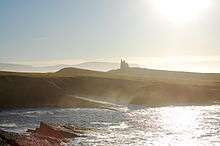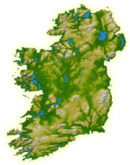Mullaghmore, County Sligo
Mullaghmore (Irish: An Mullach Mór, meaning "the great summit")[2] is a village on the Mullaghmore peninsula in County Sligo, Ireland. It is a holiday destination with a skyline dominated by Ben Bulben mountain. It is in the barony of Carbury and parish of Ahamlish.
Mullaghmore An Mullach Mór | |
|---|---|
Village | |
 Mullaghmore Harbour | |
 Mullaghmore Location in Ireland | |
| Coordinates: 54.4664°N 8.4486°W | |
| Country | Ireland |
| Province | Connacht |
| County | County Sligo |
| Population (2016)[1] | |
| • Total | 136 |
| Irish Grid Reference | G709577 |
History
From the 17th to the 19th centuries it was part of the large estate belonging to the Temple family in north Sligo. The land, some 12,000 acres, was granted to Sir John Temple, 1st Viscount Palmerston and Master of the Rolls in Dublin. The 3rd Viscount, Henry John Temple, better known as Lord Palmerston, began the building of the castle of Classiebawn, a baronial-style house standing on the peninsula. He also built the stone-walled harbour in the village, which was designed by the marine engineer Alexander Nimmo. It was built between 1822 and 1841.
The Temples were mostly absentee landlords, with the estate being run initially by middlemen, and later by land agents, such as Stewart and Kincaid,[3] a Dublin firm with offices in Sligo.[4] These agents, in their attempts to make the estates profitable, oversaw the "assisted emigration" that took place on the Palmerston and adjacent Gore Booth (Lissadell) estate that began before the famine and continued until at least the 1860s.
Thus, in May 1862, a Sligo newspaper reported: "In accordance with a custom of some years' standing, about sixty persons have been selected for emigration from the Parish of Ahamlish ... whose passages and outfit has been provided by his Lordship. They consist of twenty-four young girls, and twenty young men ... [and] families who were wholly unable to support themselves ... who had asked the favour of being sent out ... The emigrants took their passages ... this day, for Liverpool, en route for America."[5]
Lord Palmerston presided over Mullaghmore and North Sligo during the worst years of the Irish Potato famine, the great famine of the mid-19th century. During the summer and autumn of 1847, nine vessels, carrying over 2,000 persons left Sligo port with tenants evicted and "shovelled out" from his Sligo estates. They arrived in Canada half naked and totally destitute. The city of St. John in the Canadian province of New Brunswick had to take many of Palmerston's evicted tenants into care and, outraged, sent a scathing letter to Palmerston expressing regret and fury that he or his agents, ‘should have exposed such a numerous and distressed portion of his tenantry to the severity and privation of a New Brunswick winter ... unprovided with the common means of support, with broken down constitutions and almost in a state of nudity ... without regard to humanity or even common decency.’ The graves of many of these unfortunate victims can be seen today on the old quarantine station, now a museum, at Grosse Ille near Quebec.
Classiebawn was a favoured holiday retreat of Admiral of the Fleet Louis Mountbatten, 1st Earl Mountbatten of Burma, the last Viceroy of India, who had inherited Classiebawn Castle. It was off the Mullaghmore coast in August 1979 that Lord Mountbatten, along with his fourteen-year-old grandson Nicholas Knatchbull, The Dowager Baroness Brabourne and County Fermanagh teenager Paul Maxwell, were killed by a bomb planted by the Provisional IRA.
In 2007 it hosted the final stage of Rally Ireland.
Surfing
Mullaghmore is a big wave surfing destination.[6] On 8 March 2012, surfers and windsurfers from all over the world rode waves up to 15 metres (49 ft) high off Mullaghmore Head. These waves were about five metres less than the tallest wave ever recorded in Ireland in County Donegal on 13 December 2011, which was 20.4 metres (67 ft) high.[7][8]

The waves in Mullaghmore were generated by a complex weather system nicknamed the "Viking storm" leading to big wave conditions in the area for the month of March for 15 years. Some riders suffered bruising as well as broken bones and surf boards.[9][10]
A North American low-pressure system moved east and combined with another cyclone in the Western Atlantic. This system moved into an area off the coast of Ireland that already had high waves owing to a series of strong systems the previous week. In addition, a strong anticyclone over the Azores created a large pressure gradient in the North Atlantic that directed a strong fetch towards Ireland. There was also an extended fetch length in the North Atlantic in the direction of Europe while the swell was created. These combined conditions produced waves that were confirmed by satellite data on 7 March 2012 to have exceeded 15 metres (49 ft) in height.[11]
Transport
The nearest bus stop to Mullaghmore is located at Cliffoney around 5 kilometres (3.1 mi) distant and is served several times a day by Bus Éireann local and Expressway services.[12]
Notable people
- Joe McGowan (b. 1944), historian and author
References
- "Population and Actual and Percentage Change 2011 to 2016". Central Statistics Office (Ireland). Retrieved 2017-09-03.
- Mullaghmore Placenames Database of Ireland. Retrieved: 2012-03-21.
- Norton, Desmond (21 April 2019). "Landlords, tenants, famine: the business of an Irish land agency in the 1840s". University College Dublin Press. Retrieved 21 April 2019 – via Google Books.
- Desmond Norton. "On landlord-assisted emigration from some Irish estates in the 1840s" (PDF). Bahs.org.uk. Retrieved 22 April 2019.
- "Archived copy" (PDF). Archived from the original (PDF) on 2014-04-09. Retrieved 2014-04-08.CS1 maint: archived copy as title (link)
- "The best big wave surf spots in the world". SurferToday.com. Retrieved 21 April 2019.
- Giant 20-metre-high wave off Donegal Irish Times, 2011-12-13.
- Donegal wave is a new high water mark Irish Times, 2011-12-14.
- Surfers' paradise: Best March conditions in 15 years Irish Times, 2012-03-12.
- Last Minute XXL Entry From Ireland TransWorld Surf magazine, 2012-03-12.
- Ireland gets XXL surf Surfline, 2012-03-12.
- "Archived copy" (PDF). Archived from the original (PDF) on 2013-08-10. Retrieved 2013-05-02.CS1 maint: archived copy as title (link)


